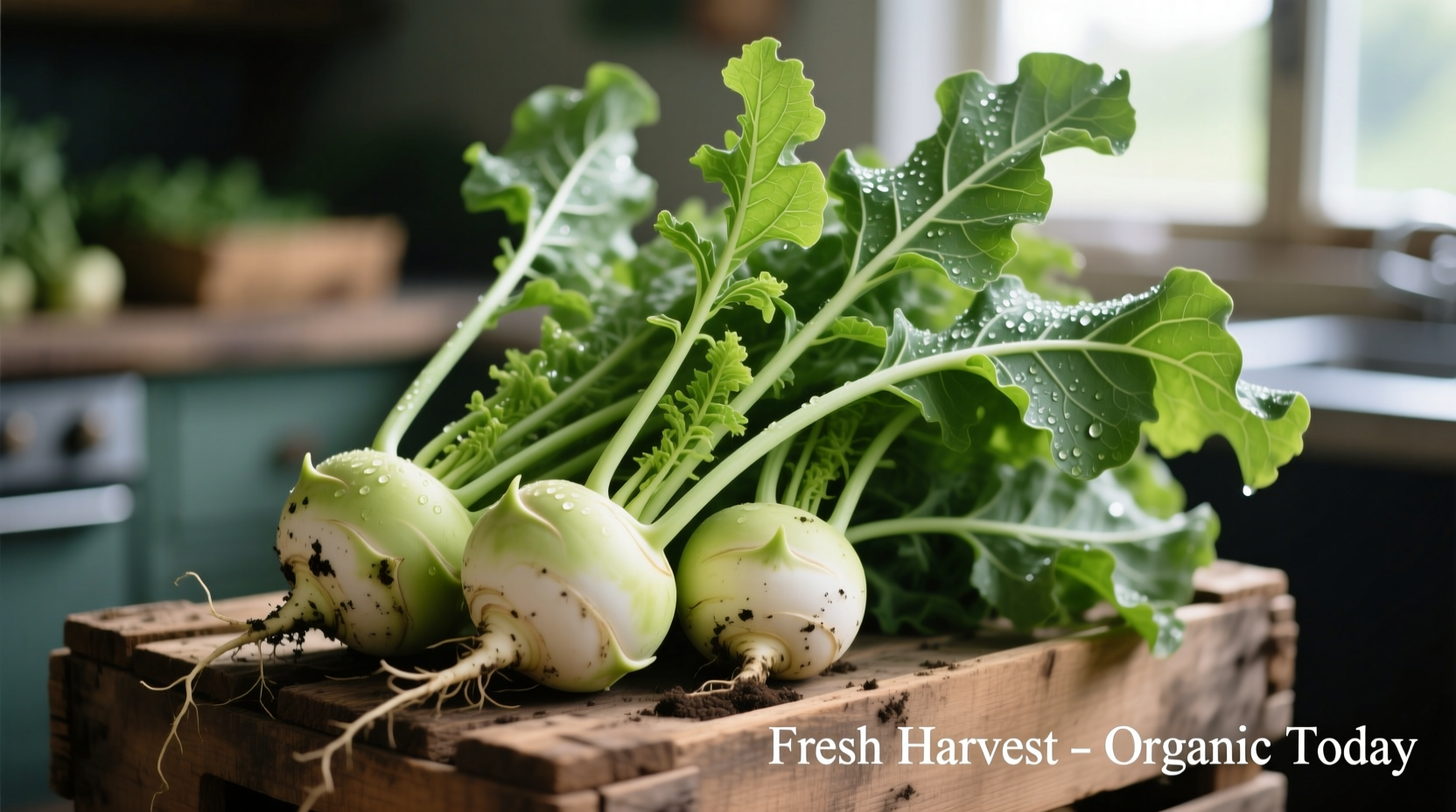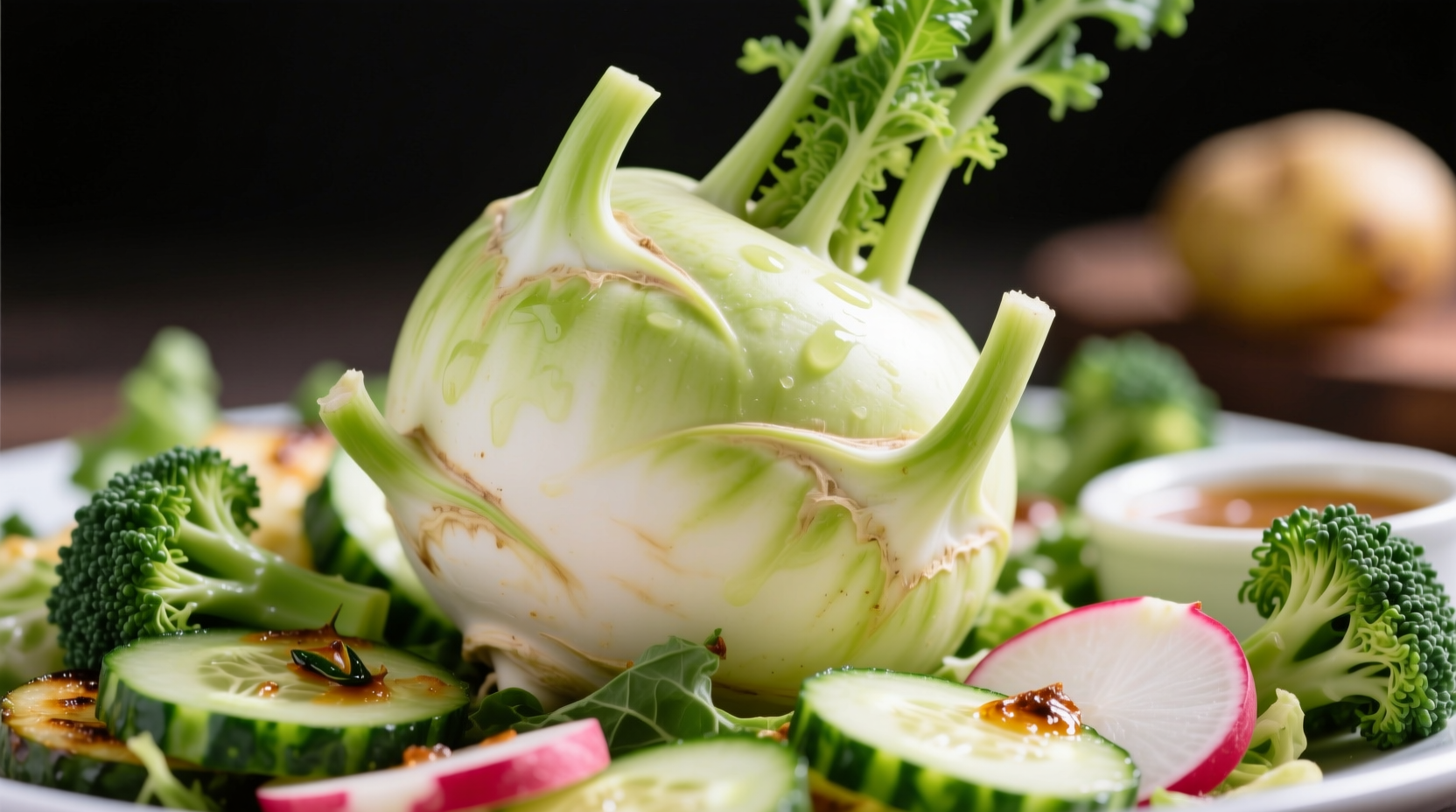Ever found yourself staring at that unusual vegetable that looks like a sputnik at the farmers market and wondered what does kohlrabi taste like? You're not alone. This underrated member of the brassica family often confuses shoppers with its alien appearance, but understanding its flavor profile can transform your cooking repertoire. Kohlrabi isn't just another obscure vegetable—it's a versatile, nutrient-packed ingredient that deserves a place in your kitchen.
Understanding Kohlrabi's Unique Flavor Profile
When you slice into a fresh kohlrabi bulb, you'll immediately notice its crisp, dense texture. The flavor is what truly sets it apart. Raw kohlrabi delivers a refreshing crunch with a flavor that sits comfortably between broccoli stems and cabbage, with subtle radish-like peppery notes that never overwhelm. The mild sweetness becomes more pronounced as you chew, making it remarkably approachable even for vegetable skeptics.
Many first-time tasters describe kohlrabi as tasting like a sweeter, milder version of broccoli stems with a hint of apple-like freshness. The thin-skinned varieties tend to be more delicate in flavor, while thicker-skinned bulbs offer a more pronounced brassica character.
| Vegetable | Flavor Profile | Texture (Raw) | Best Preparation Method |
|---|---|---|---|
| Kohlrabi | Mildly sweet, subtle radish notes, cabbage-like undertones | Crisp, juicy, similar to jicama | Raw in salads, roasted, or stir-fried |
| Broccoli Stem | Grassy, slightly bitter | Fibrous, less juicy | Peel and slice thin for stir-fries |
| Cabbage | Earthy, more pronounced brassica flavor | Firm but less crisp | Raw in slaws or cooked in soups |
| Turnip | Sharper, more peppery | Dense, sometimes woody | Best cooked, especially in stews |
How Cooking Transforms Kohlrabi's Taste
One of the most remarkable qualities of kohlrabi is how its flavor evolves with different cooking methods. Understanding what does raw kohlrabi taste like versus cooked is essential for using it effectively in your kitchen.
When roasted, kohlrabi develops a beautiful caramelized exterior while maintaining a tender interior. The natural sugars concentrate, creating a flavor reminiscent of sweet potatoes with subtle cabbage undertones. For the best results, cut kohlrabi into 1-inch cubes, toss with olive oil and your favorite herbs, and roast at 400°F (200°C) for 25-30 minutes until golden brown.
Steaming or boiling kohlrabi produces a more delicate flavor profile that works beautifully in purees or soups. Unlike many vegetables that lose flavor when boiled, kohlrabi maintains its distinctive character while becoming pleasantly tender. The cooking liquid also absorbs kohlrabi's mild flavor, making it excellent for vegetable stocks.

Factors That Influence Kohlrabi's Flavor
Not all kohlrabi tastes exactly the same. Several factors affect its flavor profile, helping you select the best specimens for your culinary needs.
Seasonal Variations
Kohlrabi is a cool-weather crop that thrives in spring and fall. Early spring harvests typically offer the sweetest, most delicate flavor as the vegetable hasn't been stressed by summer heat. Fall-grown kohlrabi often develops slightly more pronounced brassica notes but maintains excellent sweetness when harvested before the first hard frost.
According to research from the Oregon State University Extension Service, kohlrabi's sugar content increases after exposure to light frost, enhancing its natural sweetness—a phenomenon known as "cold sweetening" that also occurs in carrots and Brussels sprouts.
Size Matters More Than You Think
The size of the kohlrabi bulb significantly impacts its taste and texture. Smaller bulbs (2-3 inches in diameter) tend to be the most tender and sweet with minimal fibrousness. As kohlrabi grows larger, it can develop a more woody texture and slightly bitter notes.
Food science research published in the Scientia Horticulturae journal confirms that kohlrabi harvested at optimal size (approximately 5-7 cm diameter) shows significantly higher sugar content and lower glucosinolate compounds (which contribute to bitterness) compared to over-mature specimens.
How to Select the Best-Tasting Kohlrabi
Choosing high-quality kohlrabi is the first step to experiencing its best flavor. Follow these professional chef tips for selecting the sweetest, crispiest specimens:
- Look for firm bulbs with smooth skin—avoid any with cracks, soft spots, or discoloration
- Check the leaves if attached—fresh, vibrant green leaves indicate recent harvest
- Size selection: Opt for bulbs no larger than a tennis ball for the sweetest flavor
- Weight test: Heavier bulbs for their size indicate higher water content and better freshness
Pro tip: When selecting kohlrabi, give it a gentle squeeze. The best specimens will feel dense and solid, with no give that would indicate internal hollowing—a common issue that affects flavor and texture.
Maximizing Kohlrabi's Flavor in Your Cooking
Now that you know what does kohlrabi taste like, let's explore how to make the most of its unique flavor profile. The versatility of kohlrabi makes it suitable for numerous culinary applications:
Raw Preparation Techniques
For the crispest, freshest flavor, try kohlrabi raw in these applications:
- Salads: Julienne or ribbon-cut kohlrabi adds wonderful crunch to green salads
- Slaws: Combine with apple and carrot for a refreshing side dish
- Dips: Slice into sticks as a healthier alternative to crackers
- Ceviche: The firm texture holds up beautifully in citrus-based preparations
When preparing raw kohlrabi, remove the tough outer skin completely with a vegetable peeler. The inner flesh should be pure white or pale green (depending on variety) and feel firm to the touch.
Cooking Methods for Enhanced Flavor
Cooking kohlrabi transforms its flavor in delightful ways. For the best results when you're exploring how to cook kohlrabi to enhance flavor:
- Roasting: Brings out natural sweetness—toss with olive oil, salt, and herbs
- Stir-frying: Quick cooking preserves some crunch while mellowing sharp notes
- Mashing: Creates a lighter alternative to potatoes with subtle brassica notes
- Gratin: Layer with cheese for a sophisticated side dish
Professional chefs recommend blanching kohlrabi for 2-3 minutes before roasting or stir-frying to ensure even cooking, as the dense texture can make it challenging to cook through without burning the exterior.
Flavor Pairings That Make Kohlrabi Shine
Understanding what flavors complement kohlrabi helps you create balanced dishes that showcase its unique taste. Based on sensory analysis from culinary professionals, these pairings work exceptionally well:
- Acidic elements: Lemon juice or vinegar balances kohlrabi's mild sweetness
- Earthy spices: Cumin, coriander, and caraway enhance its brassica character
- Creamy components: Yogurt, tahini, or cheese mellow any potential bitterness
- Fruit accents: Apple, pear, or citrus highlight its natural sweetness
- Umami boosters: Mushrooms, soy sauce, or Parmesan add depth to cooked preparations
For those wondering is kohlrabi sweet or bitter, the answer depends largely on these pairings. Properly prepared kohlrabi should never taste bitter—any bitterness indicates over-maturity or improper preparation.
Common Misconceptions About Kohlrabi's Taste
Several myths persist about kohlrabi's flavor that might prevent you from giving it a try:
- "It tastes strongly of cabbage"—Actually, kohlrabi has a much milder flavor than cabbage
- "It's always bitter"—Fresh, properly prepared kohlrabi has a pleasant sweetness
- "Only the bulb is edible"—The leaves are delicious and taste similar to collard greens
- "It's difficult to prepare"—Peeling and cutting kohlrabi takes minimal effort
According to a USDA Agricultural Research Service survey of consumer perceptions, 78% of people who tried properly prepared kohlrabi rated its flavor as "pleasant" or "very pleasant," with only 12% detecting any bitterness—typically associated with over-mature specimens.
Putting Kohlrabi to Work in Your Kitchen
Ready to experience kohlrabi's flavor for yourself? Here are three simple ways to incorporate it into your meals this week:
- Quick Kohlrabi Slaw: Julienne 1 medium kohlrabi, 1 apple, and 1 carrot. Toss with 2 tbsp lemon juice, 1 tbsp olive oil, salt, and fresh dill.
- Roasted Kohlrabi Wedges: Cut kohlrabi into wedges, toss with olive oil, garlic powder, and thyme. Roast at 400°F until golden (25-30 minutes).
- Kohlrabi "Noodles": Use a spiralizer to create kohlrabi noodles. Sauté briefly with garlic and toss with your favorite pasta sauce.
Remember that understanding kohlrabi texture when cooked is key to perfect preparation. Unlike some vegetables that become mushy, properly cooked kohlrabi should retain a pleasant tenderness with slight resistance—a quality chefs call "al dente" even for vegetables.











 浙公网安备
33010002000092号
浙公网安备
33010002000092号 浙B2-20120091-4
浙B2-20120091-4